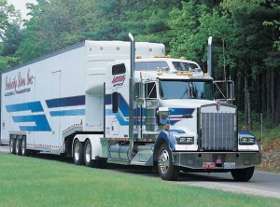Review Questions - Click On The Picture To Begin...

- Always put extra pressure on the service brake so that the rear trailer remains directly behind the first trailer
- When going around corners, you should make quick movements to swing the rear trailer around directly behind the tractor
- Be mindful that a safe speed on a curve for a straight truck or a single trailer combination vehicle may be too fast for a set of doubles or triples.
- While taking a tight turn, be sure to brake during the entire turn
Quote From The CDL Manual:
Prevent Trailers From Rolling Over - To prevent trailers from rolling over, you must steer gently and go slowly around corners, on ramps, off ramps and curves. A safe speed on a curve for a straight truck or a single trailer combination vehicle may be too fast for a set of doubles or triples.
TruckingTruth's Advice:
When it comes to driving doubles or triples, everything you do should be slower and smoother than driving a vehicle with only one trailer.
- Doubles / triples require more stopping distance to avoid a jackknife
- Doubles / triples take up more space in turns
- All of these answers are correct
- Doubles / triples tend to be blown around more during windy conditions
Quote From The CDL Manual:
Doubles and triples take up more space than other commercial vehicles. They are not only longer, but also need more space because they cannot be turned or stopped suddenly. Allow more following distance. Make sure you have large enough gaps before entering or crossing traffic. Be sure you are clear at the sides before changing lanes.
- Doubles/triples are less prone to rollovers than single trailer vehicles
- Doubles/triples don't jackknife as easily as single trailer vehicles
- Doubles/triples are easier to handle in windy conditions than single trailer vehicles
- Doubles/triples are less stable than other commercial vehicles
Quote From The CDL Manual:
Take special care when pulling two and three trailers. There are more things that can go wrong, and doubles/triples are less stable than other commercial vehicles. Some areas of concern are discussed below.
TruckingTruth's Advice:
Pulling doubles or triples are much more dangerous in nearly every aspect of driving, which is why they require an additional endorsement. Be extra cautious when driving a truck with two or more trailers.









 TT On Facebook
TT On Facebook